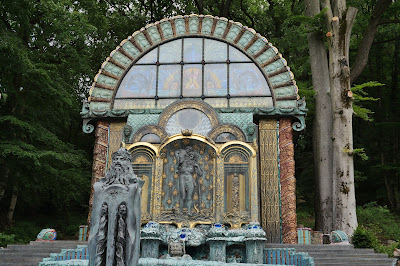We journeyed out to Hutlsdorf at the end U-Bahn line 4 and walked the mile or so to Wagner House 1 or the Fuchs Museum. You can see straightaway that it has something of a Palladian quality: a main building with two symmetrical wings, all topped with urns. Apparently Palladio was Wagner's favourite architect.
The building has quite an interesting history. It was built in 1886-88 by the architect Otto Wagner for his own occupation. By 1905 he was making plans for a new smaller house a little further along the road. It seems he saw this as being more suitable for his wife after he died (and apparently there is a German term for this type of building: “Witwensitz” or “Seat of the widow”). The house was bought by a businessman of Jewish descent named Ben Tiber and he vacated it in the 1930s when he left the country. During the Second World War the house was used by the Nazis and after the war it was left empty until 1972 when it was bought by Ernst Fuchs.
Fuchs was an artist and set about renovating the building in line with his own rather florid and exuberant taste. His then filled it with his own art works. However, he deserves great credit for saving the building from terminal decline. Happily, one wing was not altered and retains the original decorative scheme of Otto Wagner and stained glass by Koloman Moser.
Now for the tour. The entrance is round the back and you are invited to explore upstairs first. You climb the stairs lined with a wallpaper which seems at first to be quite William Morris in style, but a closer look shows a somewhat sexual element which you gradually see pervades his work along with fantasy themes.











No comments:
Post a Comment